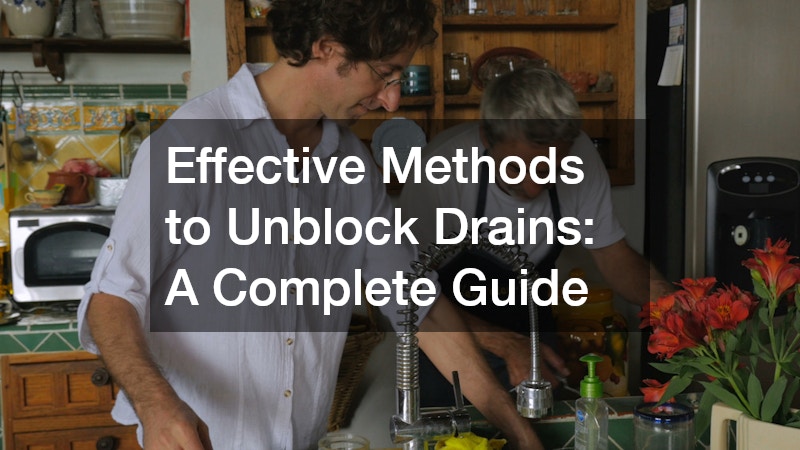Blocked drains are an unwelcome inconvenience in any household or business, often creating unpleasant odours, slow water drainage and in severe cases, water damage. Whether caused by grease build-up, tree roots, foreign objects or accumulated debris, the key to managing these issues lies in effective and timely intervention.
This guide explores practical and proven methods to unblock drains, offering homeowners and property managers a clear path toward restoring normal drainage function.
Understanding the Causes of Blocked Drains
Before tackling a blockage, it’s important to identify the cause. In kitchens, food scraps, oil and soap scum are common culprits. In bathrooms, hair, soap and toothpaste residue often accumulate over time. Outdoors, leaves, dirt and invasive tree roots can obstruct the underground pipes, particularly if the system is older or made from porous materials such as clay.
Recognising the early warning signs—such as gurgling noises, slow-draining sinks and unpleasant smells—can help prevent the situation from worsening. By understanding the cause, you can choose the most suitable unblocking method and avoid unnecessary damage to your plumbing system.
Boiling Water: The Simplest First Step
In many cases, the simplest method is also one of the most effective. Pouring boiling water down the drain can help dissolve soap residue, grease or minor build-up. This method is particularly effective for kitchen sinks affected by oil or fat, which can solidify within the pipes. However, it is crucial to note that boiling water should not be used in PVC pipes, as the intense heat could damage them. This approach works best as a preventative measure or as an initial attempt before moving on to more intensive techniques.
The Power of Natural Cleaners
For those who prefer an eco-friendly alternative to chemical solutions, a mixture of bicarbonate of soda and vinegar can be surprisingly effective. Pouring half a cup of bicarbonate of soda followed by half a cup of vinegar down the drain creates a fizzy chemical reaction that helps break down organic material. Allow the solution to sit for at least 15 minutes, then flush with hot water. This method is safe for most plumbing systems and can be repeated regularly to maintain clear drains and minimise the risk of blocked drains.
Using a Plunger for Physical Clearance
A plunger remains one of the most reliable tools in any household arsenal. It works by creating a vacuum that dislodges the blockage, making it ideal for sinks, bathtubs and toilets. To use it effectively, ensure there is enough water in the basin to cover the plunger’s rubber cup, then create a firm seal and apply strong, repetitive thrusts. If the blockage is minor or within the U-bend, a plunger often provides immediate relief without requiring chemicals or disassembly.
Plumbing Snake & Drain Auger
When the blockage is deeper within the pipe, a plumbing snake—also known as a drain auger—can be an effective tool. This flexible, coiled wire can reach further into the pipe than a plunger and physically break apart obstructions. Manual snakes are ideal for smaller jobs, while motorised versions are available for more extensive blockages. These tools are especially useful for stubborn clogs caused by hair, tissue or tree roots and are commonly used by both DIY enthusiasts and professional plumbers alike.
Chemical Drain Cleaners: Use with Caution
Chemical drain cleaners are readily available and often promise fast results. They are formulated to dissolve hair, grease and other organic materials, making them suitable for severe blockages. However, they must be used with caution. Frequent or improper use can damage pipes, particularly older systems and pose risks to health and the environment. It’s important to follow the manufacturer’s instructions carefully and ensure the area is well-ventilated during application. Consider chemical cleaners as a last resort or for emergency situations where other methods have failed.
Preventative Measures to Avoid Future Blockages
Prevention is often the best cure when it comes to drain maintenance. Avoid pouring oil or food scraps down the kitchen sink and use drain guards to catch hair and debris in bathroom drains. Periodically flushing drains with hot water or a natural cleaner can help maintain flow and prevent residue build-up. In outdoor settings, ensure gutters and stormwater drains are kept free of leaves and organic matter. For properties surrounded by trees, it may be wise to schedule regular inspections to detect and address root intrusion early.
When to Call a Professional
While many blocked drains can be resolved using home methods, there are situations where professional help is necessary. If you experience repeated blockages, multiple clogged fixtures or signs of sewage backflow, it’s time to call a licensed plumber. Professionals have access to diagnostic tools like CCTV drain cameras, allowing them to pinpoint the cause and location of the blockage accurately. Their expertise ensures that not only is the immediate problem resolved, but underlying issues—such as pipe damage or misalignment, are also addressed.
Final Thoughts
Dealing with blocked drains can be stressful, but with the right knowledge and approach, it is a manageable issue. From simple home remedies to advanced professional services, a wide range of options exist to restore normal drainage and prevent future blockages. Acting quickly and choosing the appropriate method based on the cause of the blockage can save time, money and unnecessary damage. With regular maintenance and informed decision-making, your drainage system can remain free-flowing and functional for years to come.
.




